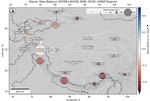Topics
*
MATCHA (Model for Atmospheric Transport and Chemistry in Asia)
A novel regional chemical reanalysis
Mountain Permafrost Extent
Quantifying and characterizing uncertainty related to mountain permafrost extent.
Terrestrial Water Cycle Changes
Insights on terrestrial water cycle changes over HMA in the past two decades (2002-2021)
Environmental Disturbance Index
Leveraging high-resolution products across the HMA region
Glacier Mass Balance Sensitivity
Calibrating and evaluating glacier mass balance models
Glacier Surface Velocities
Developing high-resolution glacier velocity products
Historical Glacial Lake Outburst Floods
Characterizing the conditions leading up to GLOFs
Model Validation and Data Assimilation
Optimizing and standardizing model evaluation and assimilation techniques
Cryosphere
Changes in the High Mountain Asia Cryosphere in response to climate change
Water Budget – Processes
Closing the water budget in High Mountain Asia





